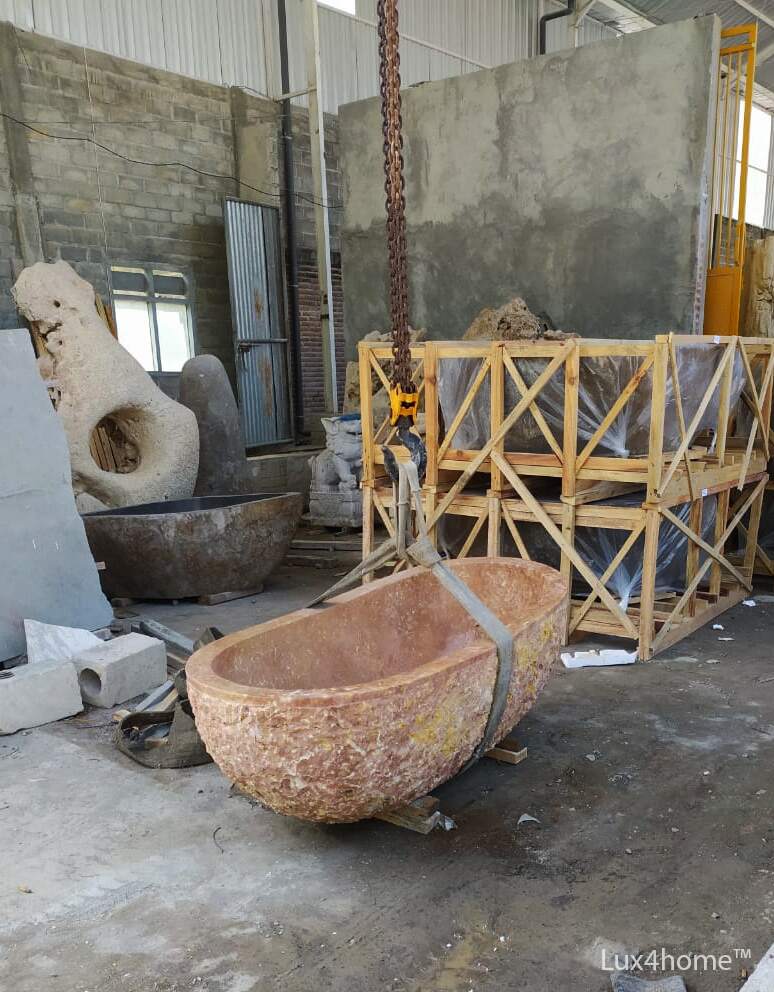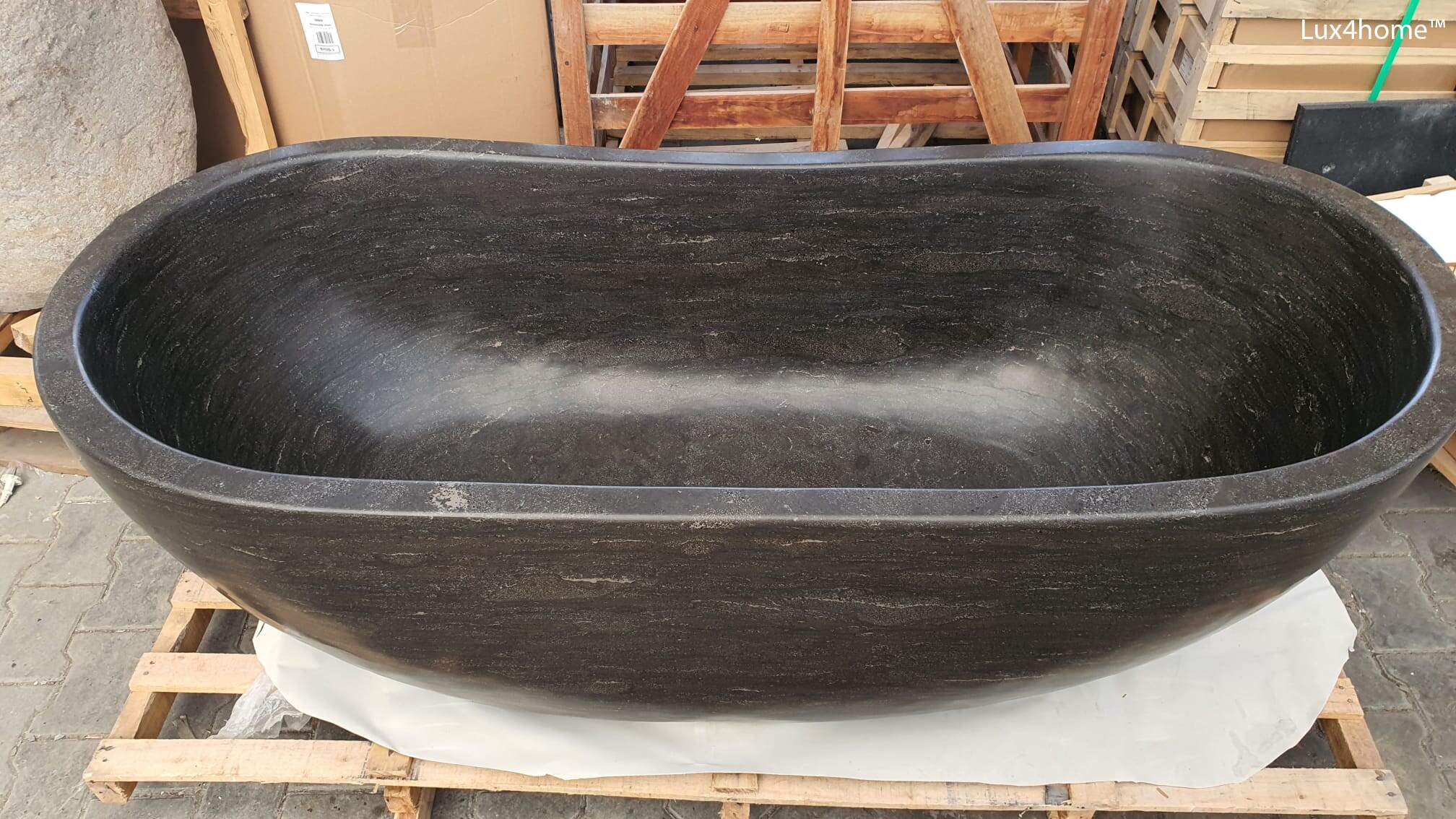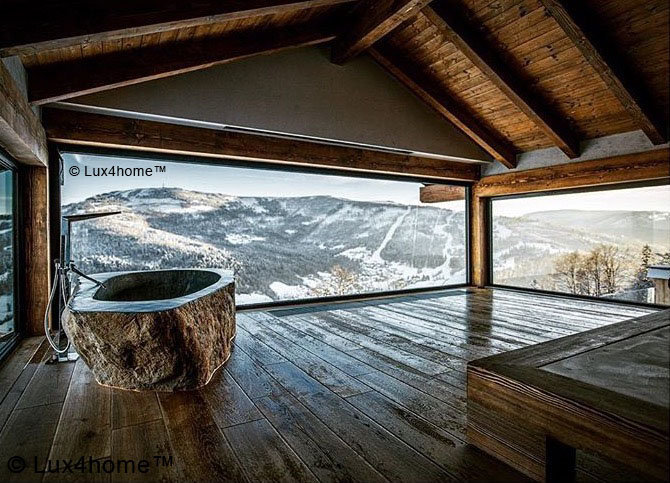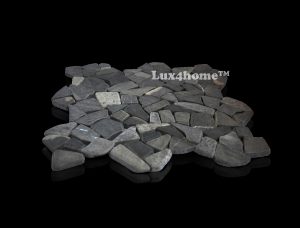Black Marble mosaic on floor Black Marble mosaic on floor...
Read MoreAre Stone Bathtubs...?
In response to the burgeoning interest and frequent inquiries from potential buyers, Lux4home™ is delighted to present the second part of its comprehensive Q&A series focused on natural stone bathtubs. This installment specifically addresses prevalent queries gathered from customers over the past three years, aiming to offer detailed information and guidance. [Part I here].
How heavy is a stone bath? / Are stone baths heavy?
The weight of a stone bath – bathtub can vary depending on the size and material it is made from.

- Each type of stone has a different density, meaning that 1 cubic centimeter will have a different weight depending on the stone type, even if the size is the same.
- Information found in some online guides suggesting that a stone bath weighs between 120-150 kg is either inaccurate or does not apply to baths made from genuine natural stone.
- The final weight of a stone bath is influenced by the type of stone, bath size, and bath model – some bath designs have thicker side walls, varying thicknesses in the base or bottom.
The average weight of a river stone bath (which is heavier than onyx, marble, similar in weight to granite, but lighter than a petrified wood bath) for a size of 200 cm x 98 cm x 68 cm (Flumen model, with relatively thick side walls of about 10 cm and a base thickness of about 14 cm) is approximately 1000 kg.
Any other bath, larger or smaller, will have a different weight accordingly.
Can a stone bathtub be placed on my floor? / Can my floor support a bathtub?
If you have any doubts, make sure to consult with your building contractor or architect. However, keep in mind that if you’re installing a stone bathtub on the ground floor, in the garden, or in a hotel building with a reinforced ceiling, you can certainly install a stone bathtub on your floor.
- If you plan to install a stone bathtub on an upper floor:
In most European countries, the permissible load on 1 m2 in new buildings is a minimum of 1 ton. However, a bathtub will exert pressure on more than 1 m2. Therefore, if your building is not made of wooden construction or is not an older building, you should be able to install the bathtub on an upper floor. - Note that our stone bathtubs have a flat bottom surface, so the pressure on the floor is not point-specific but spread over the entire area. The bottom surface of the bathtub is approximately 3 m2. Hence, if the permissible load on 1 m2 is 1 ton, theoretically, the stone bathtub can hold up to 3 tons (but such stone bathtubs usually exceed 280 cm in length).
- Restrictions in installing the bathtub due to its weight may arise if you have underfloor heating (consult this with your contractor), or if your building is wooden and you want to install the bathtub above the +1 level.
How do you move a stone bath? / How do you move a heavy bath?
- Using a small crane, a vehicle with a crane arm (e.g., HDS), or a forklift truck. This is the easiest method and works well when the construction of the house, hotel, or garden is not yet finished.
- Using a pallet truck or transport rollers when using larger equipment is not possible due to, for example, completed construction or lack of space.
- Manual lifting using straps for heavy lifting, involving a minimum of 6 people. Straps placed under the bathtub and worn on shoulders enable the tub to be moved in small sections to any location. Typically, moving companies specializing in heavy items handle this task.
Other investors have shown us methods for moving a bathtub using a lever method – in this case, a very long, for example, wooden beam supported at 1/4 of its length by a stump and propped against the lower edge of the tub acts as a lever. With this method, one person can move the bathtub in increments of several centimeters in either direction.


How do you install a stone bathtub?
Ensure you know the dimensions of the bathtub you can install. When ordering a bathtub, confirm with us whether you want the drain hole to be in the center or at the end of the tub. Prepare the drainage installation in your floor. You can install the floor before placing the tub or encase the tub after installation. Set and level your stone bathtub (if the tub is not leveled, water flow may be hindered). Connect the drainage system with a click clack plug (for tubs without an overflow, you cannot use a different type of drain plug), ensuring it is watertight. Start enjoying your stone bathtub from Lux4home™.
Can a bath be too heavy? Can a bathtub be too heavy?
Sure. If you intend to install your bathtub on an upper floor or on a floor with an underfloor heating system installed, make sure you can install a stone bathtub.
How do you clean a stone bath? How to care for a stone bathtub?
If it gives you a greater sense of user comfort, apply a natural stone impregnator to your stone bathtub, which is certified for contact with food and skin. Use any impregnators available in your country. You can use similar impregnators as those used for stone kitchen countertops. Repeat the impregnation process no less than once a year, preferably every 7 months.
Cleaning and maintaining a stone bathtub should be done using products that do not contain acids, soda, abrasive substances, or granules. It’s best to use liquids dedicated to natural stone care or simply use water with soap.

Are stone baths hard to keep clean? Are stone baths easy to clean?
Natural stone bathtubs, when properly made, are very easy to clean and maintain. Whether their external surface is natural or polished, every stone bathtub, if used correctly, won’t pose cleaning problems. Impregnating the bathtub can facilitate maintenance as the impregnator serves as an additional barrier against dirt buildup.
Do stone tubs hold heat? Are stone baths cold?
Natural stone bathtubs absorb the surrounding temperature and retain it for a prolonged period. This means that a bathtub placed in a bathroom at around 23 degrees Celsius will also assume a similar temperature. Pouring warmer water into the bathtub will cause the stone to absorb the heat, retain it, and slowly release it. Taking a bath in a natural stone bathtub allows for a longer enjoyment of warm water without a rapid loss of its temperature. A great analogy is the behavior of stones placed in a fireplace or around a hearth. Even after extinguishing the fire, the stones remain warm for many hours.
Similarly, if one desires colder water and intends to use the bathtub outdoors, a cooled stone bathtub will maintain the temperature of the cold water for an extended period during hot days or evenings. We have elaborated more on this topic in our article here.

What to Look for When Buying a Stone Bathtub? How to Purchase a Natural Stone Tub?
Suspiciously low prices for stone tubs found online often hide low-quality craftsmanship, which, after a period of use, becomes inconvenient or renders the tub unusable. We’ve addressed this issue here and have also prepared a slideshow presentation on it on YouTube.
A properly crafted stone bathtub contains no glue, putty, or paint – it consists entirely of natural stone. It’s essential that the slope of the tub’s base enables the complete drainage of water; moreover, the tub’s base should be level. Otherwise, there might be issues with water spillage after bathing. An often overlooked yet crucial aspect is the degree of polishing on the inner surface of the tub. Lower-quality polishing leads to increased stone porosity, causing the tub to absorb water, retain it, leak, and gain weight. Pay attention to the drain diameter as well, especially if you are ordering the tub in a location where you are uncertain about standard specifications. Drain diameters vary worldwide; if your drain is too large, connecting the tub to your drainage system may be impossible.
How long does a stone bathtub last? How long can I have a stone bathtub?
If you’ve purchased a properly crafted natural stone bathtub, it will remain with you forever, enduring through generations. Natural stone, when not revealing its nature during use, is practically indestructible and resistant to normal wear and tear. It also withstands changing bathroom trends. This fact is beautifully illustrated by the historical interiors of castles, palaces, and mansions. Once natural stone was used in these spaces, it remained for years, even centuries, while other elements of the interior were changed. Stone endured the test of time.





